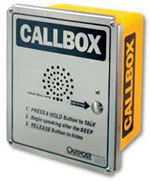There are several types of Emergency Call Boxes. The most familiar are the emergency call boxes you see along side the highways in some states. These callboxes usually have a phone-type handset and they tie into some sort of central emergency assistance command center either through wires or a wireless link.
Another type of call box just has a push button and it allows the user to speak into it without holding a handset. These too may be wired or wireless. This article discusses the type of wireless call boxes without a handset.
When someone presses a button on a wireless Emergency Call Box it transmits an alert tone to a two way radio or wireless base station intercom. Right after the sent alert tone this person can also speak a message. Whoever receives the tone and message can then respond by pressing the Talk button on their wireless device. A conversation can then be held between the two parties.
The benefit of an emergency wireless callbox is that you save money by not having to do trenching and running expensive cable to the unit. You also don’t have to pay any air-time or telephone service fees with these wireless systems. As mentioned, another benefit is that since the unit is wireless, people monitoring the units can carry handheld radios that communicate with the callbox. That allows your monitoring people to be mobile.
The range of these units is several miles, which can be extended by adding an external antenna. Some units can use radio repeaters to extend this range even more.
If you have existing two-way business radios, you’ll want a system that can integrate with them. Some emergency callboxes can be programmed to be compatible with virtually any brand of VHF or UHF business band radio.
You can get call boxes that require an FCC license, or you can get units that are certified for use on special FCC License-Free MURS Business Frequencies. If you choose a licensed version, the license is usually not too difficult or expensive to obtain.
If no AC power is available, then choose a system that lets you use battery or AC power. You can also get units that have optional solar power so that they can run for several days on a single day of sunshine.
If you need to remotely control gates, magnetic door locks, or barrier arms from your portable 2-way radio or desktop base station intercom, then select a unit that has this capability. With this ability you can let someone in a gate or door when they call you. There are units that also let you turn on a strobe light at the callbox location to help draw attention to it.
Another useful feature is the ability for call boxes to store a voice message that is played when someone presses its button. This could be a message that gives the caller specific instructions on what to do. These units can also send a second and different voice message alert to the monitoring central location or portable radios. This message could give the callboxes location or it could be an emergency message of some type.
If you have several callboxes in use and you need to know the location of the unit calling in, then you can get a call box that transmits a unique numeric identifier to a radio that has the ability to decode this identifier. This is like having a telephone with Caller ID capability.
These emergency callboxes are used for applications like parking lots, college campuses, airports, hospitals, construction sites, manufacturing facilities, resorts, hotels, farms, warehouses, delivery docks, campgrounds, gated facilities, or anywhere people may need emergency assistance. So by using an emerency call box, you can put clear wireless voice communication anywhere you need it, quickly, without expensive trenching and monthly air-time fees.
